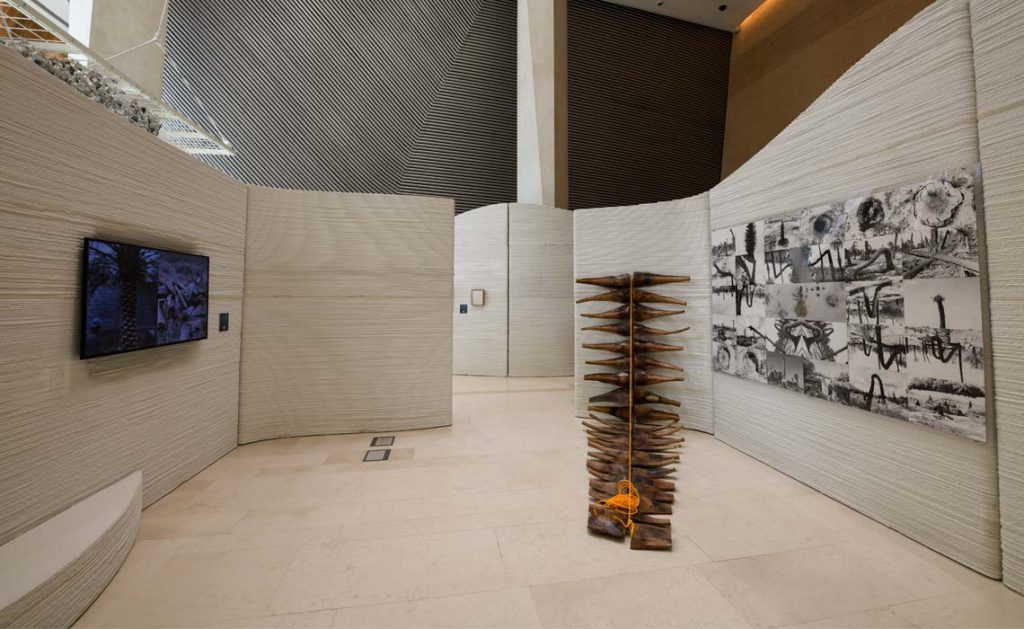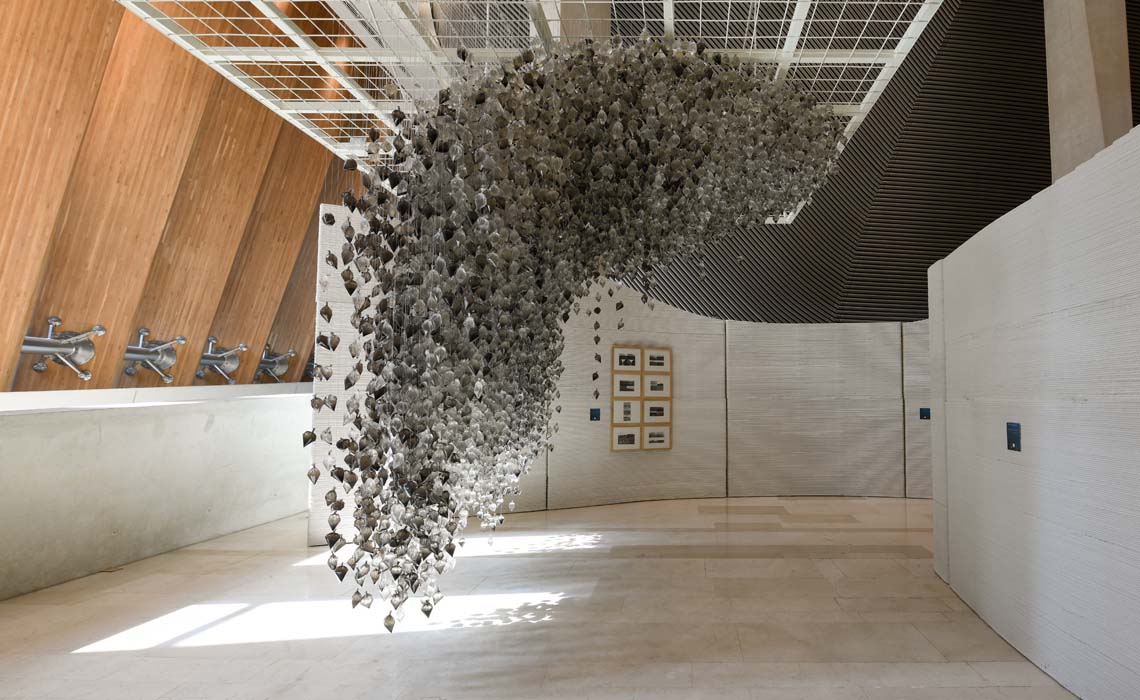Net Zero at The King Abdulaziz Center for World Culture (Ithra) highlights the relationship between humanity, technology and our environment, as well as the ever-evolving roles that are changing the way we look at art and our world
Climate change is the hottest of topics as sea levels rise, summers are increasingly defined by unprecedented heatwaves and storms grow ever more fierce, and with this, art institutions and events are scrutinising the sustainability of the industry. The current exhibition at Ithra, entitled Net Zero, proposes new ways of thinking about our engagement with the world and challenges us to look at waste within gallery spaces while trying to reduce art’s carbon footprint.
The 3D-printed gallery walls create the core of the show, representing an innovative method of promoting a circular approach to exhibitions and space configuration. Partnering with ACCIONA Cultura, a global company at the forefront of sustainable solutions for museums and events, the walls were fabricated out of concrete and designed to be reconfigured as required for countless exhibitions to come.
Curated by Candida Pestana, with assistant curator Lama Alissa, the exhibition highlights the precarious state of our world by looking at the environment and human connections. As Pestana noted, “It is crucial for us to address these topics and develop sustainable solutions for the museum and exhibitions sector… Our goal is to share the genuine perspectives, thoughts and insights of these artists with the audience.” The exhibition includes a mix of local and international artists, with nine new commissions focused on a range of environmental issues from melting polar ice and habitat destruction to atmospheric pollution and the residual traces of human presence.
Covering 71 per cent of the Earth’s surface, water is one of the most immediate and observable environmental concerns and unsurprisingly occupies a prominent place in the exhibition. Tom Hegen’s Shoreline – from The Two Degrees Celsius series (2018) – calls to mind the Paris Climate Agreement’s aim to limit global warming and subsequent sea level rise (expected to increase by 60cm by the end of the century) through poignant photographs of the Greenland ice sheet as it continues to melt.
Similarly, Philippe Parreno’s Iceman in Reality Park (1995–2019), an ice sculpture of a snowman stuck in a cycle as it melts over time, leaving behind its branches used as limbs and stones for the facial features, only to replaced again and again with another ice replica, documents the passing of time with every drop of water and the impermanence of existence.

Suspended from the ceiling, Bright Ugochukwu Eke’s Heavy Clouds (2011–22) sheds light on the direct impact of the destructive cycle of human exploitation of the environment and the toxic consequences it has on our existence. The work consists of 10,000 water-filled cellophane bags coloured as shades of black through carbon sediment, highlighting the power and importance of water while drawing attention to the pollution that consumption and production causes the planet.
SUPERFLEX looks under the sea to find solutions to human contamination by providing aquatic life with new homes as an alternative to their destroyed habitats. Through a collection of sculptures in As Close as We Get (2021–ongoing), the artist collective creates pieces intended as art for humans and as a functional infrastructure for underwater creatures. “As we learned from our experiments, we needed to create structures that maximise the surface area so that, in between the cracks and small holes across the surfaces, fish can create homes and organisms can attach themselves,” shared SUPERFLEX. “We work with different types of stone material, such as volcanic stone, sandstone and compressed marble.” The work goes beyond aesthetics and theory to identify solutions to the impacts of climate change, while looking to plants and animals as sources of inspiration and a path to new perspectives that might enable us to move forward as a society.
One of the works commissioned for the exhibition is Zahrah Alghamdi’s site-specific City of Thorns (2023), which spotlights the connection between humans and nature. Meticulously assembled, Alghamdi’s installation utilises thorns, branches and leaves stuck to a circular backdrop of epoxy resin, bringing up themes of loss and resilience. Also utilising natural plant material is Mohammad AlFaraj, with his sculpture made from the parts of a palm tree, a stop-motion film and photographic series. His works look to local folktales and tradition in contrast to modernity as climate change impacts daily life. Born in the nearby Al-Ahsa Oasis, AlFaraj often utilises natural material from the area in his work to speak to the agricultural issues of the region.
Through a thoughtful choice of artists, Net Zero sheds insightful light on the multifaceted environmental concerns we now face while continuing the crucial discourse regionally and internationally around what might constitute sustainable practices. It opens the door for discussion around how museums, galleries and institutions might implement new practices as we move towards a better relationship with the planet.
Net Zero runs until summer 2024
This feature first appeared in Canvas 110: It’s Electrifying



